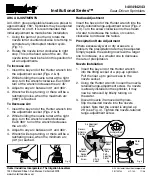
Tightly attach the pressure reducer (not included in the scope of supply) Screw the ring nut of the pressure reducer onto
the thread of the tap on the re
fill
able CO2 cylinder (or the hose with anti-bandage if
fi
tted). At this stage you must pay close
attention to the hose connected to the pressure reducer, which must not be pulled or crushed in any way. Insert the supplied
8×6 diameter hose into the quick connector on the pressure reducer. The correct position to install the cylinder is upright with
the pressure reducer next to the cylinder secured with the metal chain. If cylinders of different size and/or capacity are used,
they must be placed in the immediate vicinity of the appliance in accordance with the supplier’s instructions. Open the valve
of the CO2 cylinder by
fi
rmly holding the pressure reducer. At this stage, pay close attention to the tube connected to the
pressure reducer, which must not be pulled or crushed. Check that there are no leaks in the line. If there are, eliminate the leaks
by verifying the correct insertion of the tube in the quick couplings. Any gas venting during this operation should be considered
normal. Continuous venting after the cylinder has been screwed down is not normal: ensure that the cylinder has been screwed
down completely.
Slight venting of gas during this operation is normal.
Continuous venting after the cylinder has been screwed down is not normal.
Make sure that you have screwed the cylinder in
fi
rmly!
WARNING: Exposure to the CO jet may cause burns due to the very low temperature of the gas.
After about 1 hour from start-up, the appliance is ready for dispensing.
The correct position for installing the cylinder is vertical, with the pressure reducer on top and the cylinder underneath tied to
the cylinder rack with a chain.
The quality of carbonation depends not only on reaching the optimum temperature of the cooler, but also on the physical
characteristics of the water used. From the moment the dispenser is connected to the mains, it takes about 2 hours to obtain
optimal carbonation (without having drawn cold or carbonated water in the meantime). Start the carbonating pumps with the
button on the outside of the machine. To be switched off in case of maintenance or non-use.
MAINTENANCE
All maintenance operations, whether ordinary or extraordinary, must be carried out with the appliance switched off and the
power and water supplies disabled. Any operation on the appliance must only be carried out after having read the instructions
in the “SAFETY WARNINGS” chapter.
During the warranty period, we will not be held liable for any damage or malfunctions caused by failure to comply with the
regulations in force.
The purchaser is only authorised to intervene on the machine in the cases listed on the following pages.
Non-described or extraordinary interventions may only be carried out by the Technical Assistance Centre or Dealer
PERIODIC CLEANING AND SANITISING OF EQUIPMENT
Replace the water in the tank at least once a year or whenever it becomes dirty.
The following table is a guide to the scheduled cleaning and sanitising operations that must be carried out on the appliance,
according to the suggested frequency.
PART OF THE APPLIANCE
TYPE OF INTERVENTION
Weekly
Monthly
Quarterly
Bodywork/condenser
cleaning
Appliance hydraulic circuit
sanitation
Total equipment
sanitation/cleaning
Ice cube tank
water change/cleaning.
NOTE: The times given in the table are approximate maximums, and refer to normal conditions of use. In any case, refer to the
local health regulations (Municipality and/or Country). The frequency of intervention is directly proportional to the severity
of use of the machine.
EXTERNAL CLEANING:
for a good conservation of the machine, it is necessary to follow a scrupulous cleaning. General cleaning
of the machine must be carried out with the machine switched off using neutral detergent products diluted in water and a damp
cloth. Do not use products containing solvents or alcohol. The degree of protection of the electrical equipment guarantees
protection against splashes; in any case, it is forbidden to wet electrical connections, switches, buttons, etc. with water. The
slots located on the chassis at the rear of the machine can be cleaned with a dry brush or hoover.
1 1
A Q A d r i n k H o . R e . C a .


































